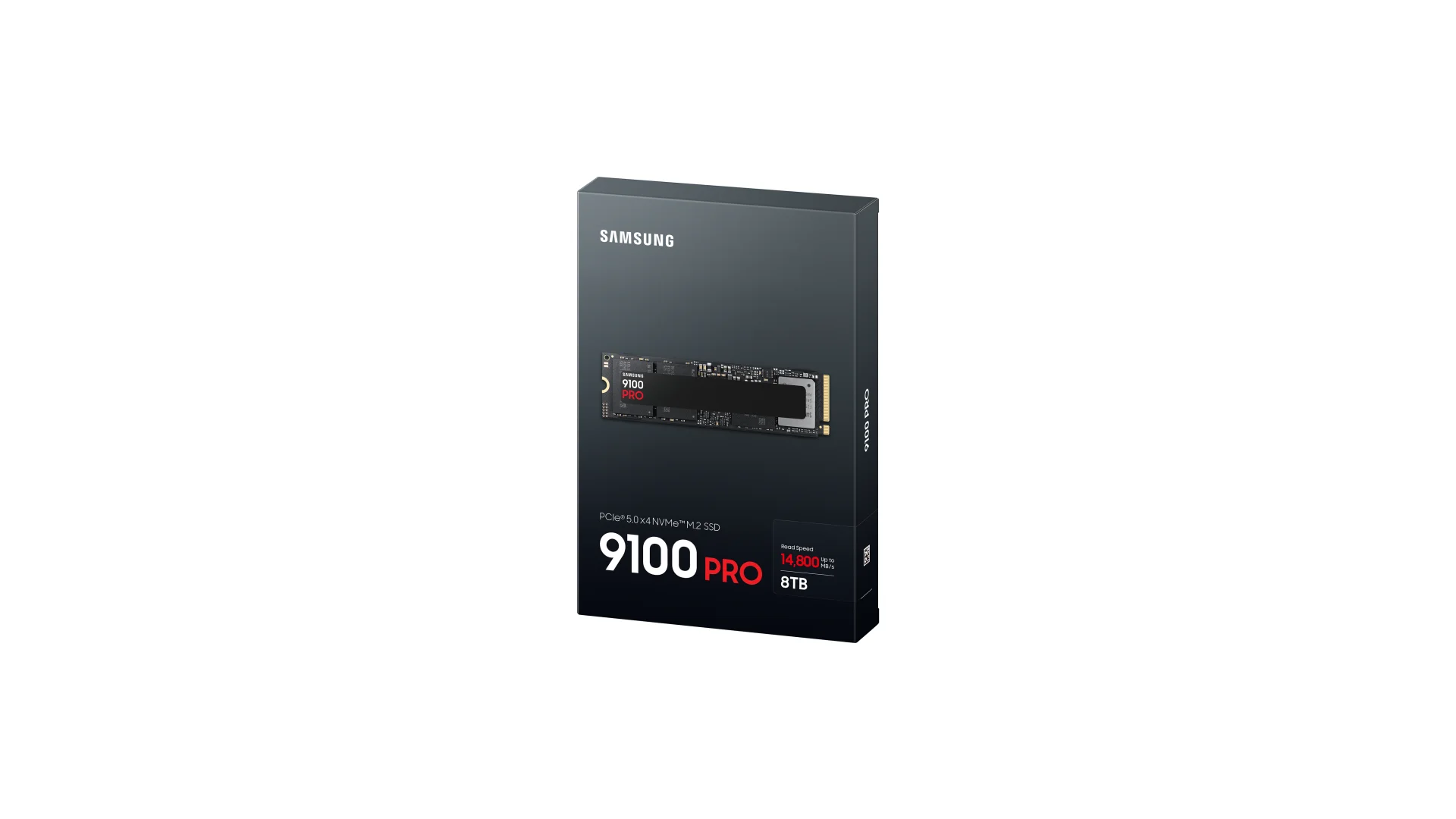Samsung Electronics has now officially launched its highest-capacity PCIe 5.0 SSD to date with the introduction of the 8TB Samsung 9100 PRO and 9100 PRO with Heatsink, marking a significant milestone in consumer storage technology. The new drives join the existing 1TB, 2TB, and 4TB variants that debuted in March 2025.
Technical Specifications and Performance Metrics
The 8TB 9100 PRO models deliver sequential read speeds of up to 14,800 MB/s and sequential write speeds reaching 13,400 MB/s – a sequential performance improvement of up to 99% over Samsung’s previous generation 990 PRO series, according to Samsung’s official announcement. The drives achieve random read/write speeds of 2,200K/2,600K IOPS respectively, specifications that directly target professional workloads including AI-based projects, 8K video editing, and high-performance gaming.
Built on Samsung’s V8 TLC V-NAND technology and featuring an in-house controller design, the 8TB model comes with a full 8GB of LPDDR4X cache memory to maintain consistent performance under sustained workloads. The endurance rating is 4,800 TBW (terabytes written). Unlike most other Samsung M.2 SSDs, the 8TB variant of the 9100 PRO features a double-sided design with four NAND flash packages to make room for the hardware.
Market Positioning and Competition
The 8TB 9100 PRO doesn’t face a lot of competition in the high-end prosumer space, with SanDisk’s WD_BLACK SN8100 series being the main competitor. Since earlier, SanDisk also offers an 8TB PCIe 4.0 option in the form of the WD_BLACK SN850X. SanDisk’s WD_BLACK SN8100, announced in May 2025, is the most direct competitor with sequential read speeds of up to 14,900 MB/s, i.e. slightly higher than Samsung’s offering. However the 8TB variant has yet to reach the market. Another competitor with more modest specifications is the TeamGroup GE PRO, which also ships in an 8TB capacity.
From a pricing perspective, the Samsung 9100 PRO 8TB will carry a $999.99 price tag in the US market.
8TB 9100 PRO, SN8100, and GE PRO Performance Comparison
| Specification | Samsung 9100 PRO 8TB | WD_BLACK SN8100 8TB | TeamGroup T-Force GE PRO 8TB |
|---|---|---|---|
| Interface | PCIe 5.0 x4, NVMe 2.0 | PCIe 5.0 x4, NVMe | PCIe 5.0 x4, NVMe 2.0 |
| Form Factor | M.2 2280 | M.2 2280 | M.2 2280 |
| NAND Type | Samsung V-NAND TLC (V8) | SanDisk BiCS8 TLC 3D CBA | 3D TLC NAND |
| Controller | Samsung In-House (Presto) | Silicon Motion SM2508 | InnoGrit IG5666 |
| DRAM | 8GB LPDDR4X | Not specified | Not specified |
| Sequential Read (MB/s) | 14,800 | 14,900 | 13,500 |
| Sequential Write (MB/s) | 13,400 | 14,000 | 11,000 |
| Random Read IOPS (QD32) | 2,200K | 2,300K | Not specified |
| Random Write IOPS (QD32) | 2,600K | 2,400K | Not specified |
| Active Power (Read/Write) | 10.5W / 8.8W | 7W average | Not specified |
| Device Sleep Power | 9.3mW / 8.6mW | Not specified | Not specified |
| Endurance (TBW) | 4,800 | Not specified | 4,800 |
| Warranty | 5 years | 5 years | 5 years |
| Market Availability | Available Now | Expected Late 2025 | Available Now |
| MSRP (USD) | $999.99 | TBA | TBA (varies by retailer) |
Samsung emphasizes improved power efficiency despite the higher performance metrics, although this is likely to be somewhat behind the highly efficient WD_BLACK competitor. The 8TB 9100 PRO consumes 10.5W during read operations and 8.8W during writes, specifications that are nevertheless competitive against other PCIe 5.0 offerings.
The availability of both standard and heatsink variants addresses different use cases, with the heatsink model maintaining an 11.25mm profile that ensures compatibility with PlayStation 5 consoles alongside traditional PC installations.
The competitive dynamics between Samsung, SanDisk, and other manufacturers have accelerated innovation in the PCIe 5.0 segment. The introduction of 8TB capacities in consumer PCIe 5.0 SSDs are a significant technological achievement, requiring advanced NAND stacking techniques that haven’t been available until now. For now, the target audience is not so much consumers as it is professional workstation users who require both speed and capacity without compromise.
As manufacturing processes mature and adoption increases, these massive capacities will gradually filter down to mainstream market segments, ultimately raising the baseline for consumer storage capacity.
